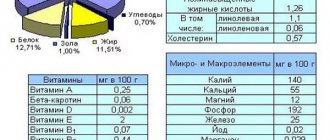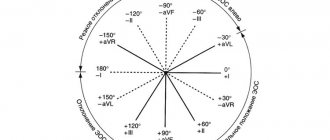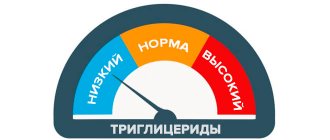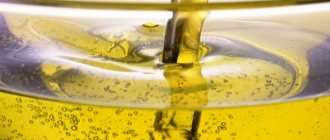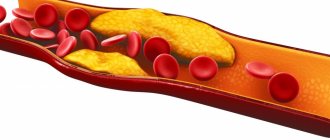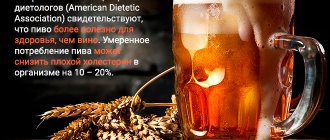General rules
Among the causes of mortality in age groups, the leading place is occupied by cardiovascular diseases, the development and progression of which is associated with atherosclerotic vascular damage. Among the risk factors that can be influenced are hyperlipidemia (increased levels of cholesterol and low-density lipoproteins), obesity , arterial hypertension , low levels of high-density lipoproteins, poor diet, smoking, diabetes mellitus , physical inactivity, and alcohol consumption.
Of these, hypercholesterolemia in combination with arterial hypertension and smoking are the most significant risk factors for CVD. A connection has been proven between mortality from ischemic heart disease and the level of cholesterol in the blood. Exceeding its level by 5.0 mmol/l increases the risk of mortality in 23% of cases.
The main carriers of cholesterol to tissues are LDL, and 70% of all cholesterol is associated with them. HDL is formed in the liver and intestines and absorbs free cholesterol and removes it from the body. They can be called beneficial lipoprotein . High levels of these lipoproteins, on the contrary, prevent the development of heart and vascular diseases. An imbalance between LDL/HDL is also considered dangerous.
Cholesterol levels are related to diet. Excessive consumption of animal fat, which contains saturated fatty acids, cholesterol and trans fatty acids, has been shown to be important in hypercholesterolemia . By changing the patient's diet, it is possible to reduce cholesterol levels by 10-15%.
The main measures to combat high cholesterol levels are: a cholesterol-lowering diet, increasing physical activity in accordance with age and normalizing weight. It is known that with obesity, LDL levels increase and low levels of HDL in the blood are detected. Increasing physical activity increases metabolism and accelerates the mobilization of fat from the depot.
What is a low-cholesterol diet? The most important condition for changing lipid metabolism with diet is the qualitative and quantitative correction of the fat component of the diet. This is a therapeutic diet that involves limiting the intake of cholesterol and animal fats from food. The degree of restriction of cholesterol supplied with food depends on the level of its increase and can be 250-300 mg/day.
For moderate hypercholesterolemia - no more than 300 mg, for severe hypercholesterolemia - 200 mg. The cholesterol content in foods is reflected in the food table, which is easy to find on websites. Products with a high content of it include: brains, kidneys, liver of all types of animals and poultry, pork, stellate sturgeon, oysters, carp, squid, fish caviar, butter, pork, goose, duck fat, high-fat cheeses, egg yolk.
- Cholesterol foods are excluded from the diet.
- The total fat content in the diet is reduced to 70 g or less. Only 8% should be SFA (saturated fatty acids). Sources of EFAs are fatty meats, animal fats, sausages, and fatty dairy products. In addition to SFAs, consumption of trans isomers of fats, which are formed during the production of margarines (more than 10% of them in margarine), is associated with an increased risk of atherosclerosis.
- Introduction of vegetable oils into the diet, which should make up half of the fat component. They contain MUFA and PUFA, as well as anti-atherogenic components ( phospholipids , phytosterols , squalene and phytostanols ). Phospholipids stabilize cholesterol in bile and, in addition, reduce its absorption in the intestine. It must be remembered that when oils are refined, the bulk of phospholipids are lost, so you need to use unrefined, cold-pressed oils.
- If you are obese, it is important to reduce your caloric intake. For this purpose, the consumption of simple carbohydrates, animal fats and alcohol, which significantly increase the energy value of food, is sharply limited. An increase in calorie intake is accompanied by increased synthesis of cholesterol in the body and an increase in its level in the blood, as well as LDL and VLDL. Low carbohydrate content helps reduce bad cholesterol. In this regard, sugar, flour and confectionery products, potatoes, and any baked goods are excluded.
- Enriching the diet with dietary fiber is complex carbohydrates that help reduce atherogenic fractions of lipoproteins and reduce excess weight. Dietary fiber is represented by products of plant origin. For the most part, they are not digested and remove excess cholesterol from the intestines, absorbing it on themselves. The wide inclusion of vegetables, grains and fruits allows you to provide the body with 30-50 g of them per day. If necessary, their consumption is increased at the expense of wheat bran. But long-term consumption in large doses is undesirable due to impaired absorption of microelements and vitamins.
- Introduction of vegetable protein - cereals, legumes (preferably soy products). This is due to the fact that the value of soy protein is higher than other plant proteins, and in some cases it can replace animal protein. Soy has a wide vitamin and mineral composition and isoflavones , which have hypolipidemic and thrombolytic effects. You need to consume 25 g of soy protein daily (preferably soy protein).
- When cooking foods, a minimum of fat is used, which allows you to reduce the caloric content of the diet. This is possible when steaming, boiling or baking. Removing fat and extractive substances from fish and meat products is possible by preliminary boiling - in this case up to 40-50% of the fat is lost.
All these requirements are met by the standard therapeutic Diet No. 10C , which is recommended for hypercholesterolemia , atherosclerosis and ischemic heart disease. It is aimed at normalizing general metabolism and lipid metabolism, slowing the progression of atherosclerosis . Contains a physiological amount of proteins, it contains a limited amount of animal fat (70 g), simple carbohydrates and salt (4 g). If you are obese , fats and carbohydrates are further limited, and calorie content should be no more than 1800-2000 kcal.
In addition to following general nutritional rules, you need to enrich your diet with microelements, some vitamins, phytosterols, squalene and antioxidants , which also play a role in normalizing lipid metabolism. These include:
- Iodine, which is necessary for normal thyroid function and prevents the deposition of lipids in the wall of blood vessels, which makes the formation of atherosclerotic plaque impossible. Its sources: sea cucumbers, mussels, sea fish, shrimp, seaweed.
- Chromium, whose role is associated with hypocholesterolemic and hypoglycemic effects and the ability to prevent lipid deposition. Its main sources: wholemeal flour, legumes, lean meat, pearl barley and corn grits.
- Antioxidants that suppress oxidative stress are also important in hypercholesterolemia. Vitamin E (seeds, vegetable oils, nuts, legumes), vitamin C (vegetables and fruits), vitamins B (meat, fish, seafood, milk, green onions, soybeans, beans, cauliflower, wholemeal flour , millet, buckwheat and oatmeal) and vitamin A (beta carotene from carrots, red peppers, spinach, sorrel, green onions, sea buckthorn, tomatoes, rowan). Vitamin A is also contained in animal products (butter, liver, egg yolk), but their consumption is prohibited for this disease.
- Selenium, as an antioxidant, is also important for high cholesterol levels. It is contained in wheat and oat bran, pink salmon, sunflower seeds, whole grain bread, chickpeas, beans and lentils, so it is important to include these products in your diet.
- It is useful to eat foods rich in squalene - it is found in amaranth seed oil. It contains 8 times more of it than in shark liver. To reduce cholesterol, you need to take 2 tsp of oil. morning and evening during meals. Omega-3 and Omega-6 , potassium, magnesium, carotenoids and vitamins in this oil increases its value in the treatment of hypercholesterolemia, vascular and heart diseases.
- Phytosterols reduce the amount of cholesterol absorption in the intestine. They are present in sea buckthorn, soybean, coconut, rapeseed and corn oil, olive oil (22 mg in one tablespoon), found in wheat germ, flax and sesame seeds, pumpkin seeds, sunflower seeds, pistachios, pine nuts, almonds, avocados.
- Fermented milk products (Danacor, “Profilakt 120/80”), enriched with phytosterols, are classified as “functional” products for correcting cholesterol levels, and therefore should be consumed by patients.
About forbidden food
If we describe specific prohibited foods during a cholesterol diet, then this list contains the following names:
- fatty meat: lamb, pig, cow;
- margarine, heavy cream and other high-fat dairy products;
- rich meat broths;
- baked goods and baked goods, including bread products;
- smoked food, sausages, sausages, etc.;
- ready-made sauces – mayonnaise, ketchup;
- salo;
- fried vegetables;
- fatty fish.
Margarine is a product that doctors recommend avoiding even for people with normal cholesterol levels.
Eating only healthy foods and giving up your favorite meat, mayonnaise, spices and lard is not something everyone can do. But only with effort can you reduce the amount of dangerous and harmful substances in the body. Carbonated drinks such as Coca-Cola, fast food, canned food and processed foods are also prohibited.
In addition to avoiding “harmful” foods, you should follow a number of rules when eating and preparing food:
- give up sugar and table salt. You can replace salt with fresh lemon juice, and instead of sugar, use cinnamon in powder form;
- instead of frying, cook food in other ways - boil, stew, steam, bake in the oven without the use of margarine and fats;
- drink at least 1.5–2 liters of clean water per day to enhance the effect of removing toxins from the body;
- include vegetable fats instead of animal fats in your daily diet.
Doctors say that seafood is good for high cholesterol due to its high iodine content. But it is better to refrain from eating caviar, shrimp and squid, or eat them, but not more often than once a week.
No ads 3
Authorized Products
- The basis of the diet is vegetables and fruits. They should be consumed at every meal. When choosing them, consider the color. Thus, red and purple fruits and vegetables contain polyphenols, and they stimulate the production of beneficial HDL. These are dogwood, raspberries, red grapes, blueberries, viburnum pomegranate, strawberries, blackberries, cranberries, chokeberries, lingonberries, beets, eggplants, purple cabbage. Persimmons, sweet peppers, kiwi, and pumpkin are also useful. It is advisable to consume fruits and berries raw.
- The side dish for meat and fish should also be vegetable. You can prepare a vegetable mix - stew. During the vegetable season, you can switch to eating fresh salads. Eating white cabbage is healthy in any form and should be included in your diet daily. The same applies to seaweed, which can be added to all salads and main courses. If you are overweight, limit your consumption of potatoes.
- Based on this, vegetable soups are also preferred (cabbage soup, beetroot soup, borscht, rassolnik). They are boiled in water and not fried.
- In second place are fish and seafood dishes, which are preferred over meat dishes. You can alternate low-fat fish with fatty ones (mackerel, tuna, salmon, herring, halibut, salmon). It is important to use fatty sea fish in the diet because it is a source of omega-3 , which help reduce hypercholesterolemia and blood clots. Cooking - steaming or baking without fat.
- Lean meat and poultry. To reduce fat and extractives, pre-boiling is recommended.
- Bread should be consumed from whole grain flour or with bran, yeast-free bread with bran.
- Various vegetable oils are used in dishes. A representative of the MUFA is oleic acid—olive oil is rich in it. People who consume sea fish and olive oil have a low percentage of heart diseases. omega-6 fatty acids , and flaxseed, sesame, soybean, mustard, walnut, and rapeseed are representatives of omega-3 fatty acids. It will be useful to alternate all the oils in your diet.
- Low-fat milk and fermented milk products. This applies to cottage cheese and cheese (20-30% fat content).
- Any cereals. Based on the rules of healthy eating, porridge is consumed as a separate dish, and not as a side dish for meat or fish. Cereal and dough dishes are limited in case of increased weight.
- Eggs (whole) up to 4 per week and whites - without restrictions.
- You can drink weak tea, coffee drinks, vegetable and berry juices, herbal teas, infusions of rose hips and wheat bran.
- The issue of alcohol consumption is resolved as follows: red (white) wine is allowed in the amount of 150 ml per day, and strong drinks (vodka, cognac, whiskey - no more than 50 ml). Beer is excluded. Of the listed drinks, red wine is preferable.
Table of permitted products
| Proteins, g | Fats, g | Carbohydrates, g | Calories, kcal | |
Vegetables and greens | ||||
| eggplant | 1,2 | 0,1 | 4,5 | 24 |
| beans | 6,0 | 0,1 | 8,5 | 57 |
| zucchini | 0,6 | 0,3 | 4,6 | 24 |
| cabbage | 1,8 | 0,1 | 4,7 | 27 |
| broccoli | 3,0 | 0,4 | 5,2 | 28 |
| Brussels sprouts | 4,8 | 0,0 | 8,0 | 43 |
| cauliflower | 2,5 | 0,3 | 5,4 | 30 |
| green onion | 1,3 | 0,0 | 4,6 | 19 |
| bulb onions | 1,4 | 0,0 | 10,4 | 41 |
| carrot | 1,3 | 0,1 | 6,9 | 32 |
| cucumbers | 0,8 | 0,1 | 2,8 | 15 |
| squash | 0,6 | 0,1 | 4,3 | 19 |
| salad pepper | 1,3 | 0,0 | 5,3 | 27 |
| parsley | 3,7 | 0,4 | 7,6 | 47 |
| salad | 1,2 | 0,3 | 1,3 | 12 |
| beet | 1,5 | 0,1 | 8,8 | 40 |
| celery | 0,9 | 0,1 | 2,1 | 12 |
| soybeans | 34,9 | 17,3 | 17,3 | 381 |
| asparagus | 1,9 | 0,1 | 3,1 | 20 |
| tomatoes | 0,6 | 0,2 | 4,2 | 20 |
| Jerusalem artichoke | 2,1 | 0,1 | 12,8 | 61 |
| pumpkin | 1,3 | 0,3 | 7,7 | 28 |
| dill | 2,5 | 0,5 | 6,3 | 38 |
| beans | 7,8 | 0,5 | 21,5 | 123 |
| garlic | 6,5 | 0,5 | 29,9 | 143 |
| lentils | 24,0 | 1,5 | 42,7 | 284 |
Fruits | ||||
| avocado | 2,0 | 20,0 | 7,4 | 208 |
| oranges | 0,9 | 0,2 | 8,1 | 36 |
| pomegranate | 0,9 | 0,0 | 13,9 | 52 |
| grapefruit | 0,7 | 0,2 | 6,5 | 29 |
| pears | 0,4 | 0,3 | 10,9 | 42 |
| lemons | 0,9 | 0,1 | 3,0 | 16 |
| mango | 0,5 | 0,3 | 11,5 | 67 |
| tangerines | 0,8 | 0,2 | 7,5 | 33 |
| nectarine | 0,9 | 0,2 | 11,8 | 48 |
| peaches | 0,9 | 0,1 | 11,3 | 46 |
| apples | 0,4 | 0,4 | 9,8 | 47 |
Berries | ||||
| gooseberry | 0,7 | 0,2 | 12,0 | 43 |
| Red currants | 0,6 | 0,2 | 7,7 | 43 |
| black currant | 1,0 | 0,4 | 7,3 | 44 |
Nuts and dried fruits | ||||
| nuts | 15,0 | 40,0 | 20,0 | 500 |
| almond | 18,6 | 57,7 | 16,2 | 645 |
| flax seeds | 18,3 | 42,2 | 28,9 | 534 |
| fenugreek seeds | 23,0 | 6,4 | 58,3 | 323 |
| sunflower seeds | 20,7 | 52,9 | 3,4 | 578 |
Cereals and porridges | ||||
| buckwheat (kernel) | 12,6 | 3,3 | 62,1 | 313 |
| oat groats | 12,3 | 6,1 | 59,5 | 342 |
| cereals | 11,9 | 7,2 | 69,3 | 366 |
| wheat bran | 15,1 | 3,8 | 53,6 | 296 |
Raw materials and seasonings | ||||
| basil | 2,5 | 0,6 | 4,3 | 27 |
| honey | 0,8 | 0,0 | 81,5 | 329 |
Dairy | ||||
| kefir 0% | 3,0 | 0,1 | 3,8 | 30 |
| kefir 1% | 2,8 | 1,0 | 4,0 | 40 |
Cheeses and cottage cheese | ||||
| cottage cheese 0.6% (low fat) | 18,0 | 0,6 | 1,8 | 88 |
| curd tofu | 8,1 | 4,2 | 0,6 | 73 |
Meat products | ||||
| beef | 18,9 | 19,4 | 0,0 | 187 |
Bird | ||||
| chicken fillet | 23,1 | 1,2 | 0,0 | 110 |
| turkey | 19,2 | 0,7 | 0,0 | 84 |
Eggs | ||||
| eggs | 12,7 | 10,9 | 0,7 | 157 |
Fish and seafood | ||||
| fish | 18,5 | 4,9 | 0,0 | 136 |
| seaweed | 0,8 | 5,1 | 0,0 | 49 |
Oils and fats | ||||
| grape seed oil | 0,0 | 99,9 | 0,0 | 899 |
| linseed oil | 0,0 | 99,8 | 0,0 | 898 |
| olive oil | 0,0 | 99,8 | 0,0 | 898 |
| sunflower oil | 0,0 | 99,9 | 0,0 | 899 |
Non-alcoholic drinks | ||||
| mineral water | 0,0 | 0,0 | 0,0 | — |
| instant chicory | 0,1 | 0,0 | 2,8 | 11 |
| green tea | 0,0 | 0,0 | 0,0 | — |
| * data is per 100 g of product | ||||
Basic Rules
The basic rules of the lipid-lowering weight loss method differ little from other diets. In principle, this is simply a program of proper nutrition, in which you need to exclude easily digestible carbohydrates and foods containing large amounts of cholesterol: butter, lard, fermented milk products, processed foods, cheeses, smoked meats.
General rules:
- fractional meals in small portions (5-6 times a day, 200-250 g);
- dinner or snack three hours before bed;
- give preference to boiling, stewing and steaming;
- create a diet with a daily amount of calories – 1200-1300 kcal;
- adhere to the correct drinking regime;
- reduce salt intake;
- replace animal fats with vegetable ones;
- eat rye or whole grain bread.
Below you will find a list of prohibited and permitted foods, thanks to which you can create a diet that allows you to eat a varied diet. This is especially important for people who are indicated to adhere to a diet constantly.
Fully or partially limited products
- High cholesterol products, sausages, canned food and all kinds of smoked meats, fatty pork, duck and goose meat, refractory animal fats, canned fish, smoked fish and caviar are completely excluded.
- Meat and fish broths.
- Products made from puff pastry or butter dough, products with cream. For obesity - sugar, sweets, jam, confiture, chocolate, ice cream.
- Fatty dairy products (cheese, cream, cottage cheese, sour cream).
Table of prohibited products
| Proteins, g | Fats, g | Carbohydrates, g | Calories, kcal | |
Fruits | ||||
| bananas | 1,5 | 0,2 | 21,8 | 95 |
Nuts and dried fruits | ||||
| raisin | 2,9 | 0,6 | 66,0 | 264 |
Cereals and porridges | ||||
| semolina | 10,3 | 1,0 | 73,3 | 328 |
| white rice | 6,7 | 0,7 | 78,9 | 344 |
Flour and pasta | ||||
| pasta | 10,4 | 1,1 | 69,7 | 337 |
Bakery products | ||||
| bagels | 16,0 | 1,0 | 70,0 | 336 |
| bagels | 16,0 | 1,0 | 70,0 | 336 |
| crackers | 11,2 | 1,4 | 72,2 | 331 |
Confectionery | ||||
| jam | 0,3 | 0,2 | 63,0 | 263 |
| jam | 0,3 | 0,1 | 56,0 | 238 |
| candies | 4,3 | 19,8 | 67,5 | 453 |
| pastry cream | 0,2 | 26,0 | 16,5 | 300 |
Ice cream | ||||
| ice cream | 3,7 | 6,9 | 22,1 | 189 |
Cakes | ||||
| cake | 4,4 | 23,4 | 45,2 | 407 |
Chocolate | ||||
| chocolate | 5,4 | 35,3 | 56,5 | 544 |
Raw materials and seasonings | ||||
| ketchup | 1,8 | 1,0 | 22,2 | 93 |
| mayonnaise | 2,4 | 67,0 | 3,9 | 627 |
Dairy | ||||
| cream | 2,8 | 20,0 | 3,7 | 205 |
| sour cream 30% | 2,4 | 30,0 | 3,1 | 294 |
| sour cream 40% (fat) | 2,4 | 40,0 | 2,6 | 381 |
Cheeses and cottage cheese | ||||
| cheese | 24,1 | 29,5 | 0,3 | 363 |
| cottage cheese 18% (fat) | 14,0 | 18,0 | 2,8 | 232 |
Meat products | ||||
| pork | 16,0 | 21,6 | 0,0 | 259 |
| pork liver | 18,8 | 3,6 | 0,0 | 108 |
| pork kidneys | 13,0 | 3,1 | 0,0 | 80 |
| pork fat | 1,4 | 92,8 | 0,0 | 841 |
| salo | 2,4 | 89,0 | 0,0 | 797 |
| beef liver | 17,4 | 3,1 | 0,0 | 98 |
| beef kidneys | 12,5 | 1,8 | 0,0 | 66 |
| beef brains | 9,5 | 9,5 | 0,0 | 124 |
| mutton | 15,6 | 16,3 | 0,0 | 209 |
Sausages | ||||
| smoked sausage | 16,2 | 44,6 | 0,0 | 466 |
| smoked sausage | 9,9 | 63,2 | 0,3 | 608 |
| sausages | 10,1 | 31,6 | 1,9 | 332 |
| sausages | 12,3 | 25,3 | 0,0 | 277 |
Bird | ||||
| smoked chicken | 27,5 | 8,2 | 0,0 | 184 |
| duck | 16,5 | 61,2 | 0,0 | 346 |
| smoked duck | 19,0 | 28,4 | 0,0 | 337 |
| goose | 16,1 | 33,3 | 0,0 | 364 |
Fish and seafood | ||||
| smoked fish | 26,8 | 9,9 | 0,0 | 196 |
| salted fish | 19,2 | 2,0 | 0,0 | 190 |
| Red caviar | 32,0 | 15,0 | 0,0 | 263 |
| black caviar | 28,0 | 9,7 | 0,0 | 203 |
| squid | 21,2 | 2,8 | 2,0 | 122 |
| shrimps | 22,0 | 1,0 | 0,0 | 97 |
| salmon | 19,8 | 6,3 | 0,0 | 142 |
| sturgeon | 16,4 | 10,9 | 0,0 | 163 |
| canned fish | 17,5 | 2,0 | 0,0 | 88 |
| semi-finished fish products | 12,5 | 6,7 | 14,7 | 209 |
| sardine | 20,6 | 9,6 | — | 169 |
| mackerel | 18,0 | 13,2 | 0,0 | 191 |
| cod (liver in oil) | 4,2 | 65,7 | 1,2 | 613 |
| boiled oysters | 14,0 | 3,0 | — | 95 |
| fresh oysters | 14,0 | 6,0 | 0,3 | 95 |
Oils and fats | ||||
| butter | 0,5 | 82,5 | 0,8 | 748 |
| creamy margarine | 0,5 | 82,0 | 0,0 | 745 |
| coconut oil | 0,0 | 99,9 | 0,0 | 899 |
| palm oil | 0,0 | 99,9 | 0,0 | 899 |
| rendered beef fat | 0,0 | 99,7 | 0,0 | 897 |
| cooking fat | 0,0 | 99,7 | 0,0 | 897 |
| rendered pork fat | 0,0 | 99,6 | 0,0 | 896 |
Non-alcoholic drinks | ||||
| cola | 0,0 | 0,0 | 10,4 | 42 |
| lemonade | 0,0 | 0,0 | 6,4 | 26 |
| Pepsi | 0,0 | 0,0 | 8,7 | 38 |
| sprite | 0,1 | 0,0 | 7,0 | 29 |
| * data is per 100 g of product | ||||
Hypocholesterol diet menu for a week (Diet)
Taking into account the permitted foods and dietary habits, it is not difficult to create a menu for the week. It is important to increase the amount of vegetables, fruits and polyunsaturated fatty acids in the diet. It is advisable to consume up to 500 g of fruits and vegetables daily.
A large amount of dietary fiber is found in oatmeal (whole), prunes, gooseberries, cranberries, figs, raspberries, dates, raisins, bran and dried apricots. You will forever have to give up sausages, liver pates, ham, fatty cheeses, sugar, sweets, cakes and cream pies, jams, preserves and sweet pastries. You can maintain HDL levels by eating flax seeds, walnuts, soy products and occasionally fatty fish.
An approximate menu for a standard hypocholesterolemic diet might look like this:
| Breakfast |
|
| Lunch |
|
| Dinner |
|
| Afternoon snack |
|
| Dinner |
|
| For the night |
|
| Breakfast |
|
| Lunch |
|
| Dinner |
|
| Afternoon snack |
|
| Dinner |
|
| For the night |
|
| Breakfast |
|
| Lunch |
|
| Dinner |
|
| Dinner |
|
| For the night |
|
| Breakfast |
|
| Lunch |
|
| Dinner |
|
| Afternoon snack |
|
| Dinner |
|
| For the night |
|
| Breakfast |
|
| Lunch |
|
| Dinner |
|
| Afternoon snack |
|
| Dinner |
|
| For the night |
|
| Breakfast |
|
| Lunch |
|
| Dinner |
|
| Afternoon snack |
|
| Dinner |
|
| For the night |
|
| Breakfast |
|
| Lunch |
|
| Dinner |
|
| Afternoon snack |
|
| Dinner |
|
| For the night |
|
Expert opinion
A lipid-lowering diet should be used as part of the treatment of certain diseases under the direct supervision of a physician. It plays a supporting role, but not a determining one. Without appropriate therapy, it is impossible to cure, for example, heart disease with diet alone. Such pathologies should be treated exclusively in a hospital setting under constant supervision. As for weight correction, you definitely shouldn’t expect great results from a lipid diet. It is generally impossible to maintain a low-calorie diet for a long time without medical indications. The best option for losing weight is proper nutrition, physical activity and the ability to control eating habits.
Low-cholesterol diet, recipes
All the recipes below can be made in a slow cooker.
First meal
Soup from prefabricated vegetables
Zucchini, carrots, bell peppers, potatoes (can be replaced with cauliflower), green beans, green peas.
Place potatoes, carrots and green beans in boiling water and simmer for 10 minutes. Then add bay leaf, onion, bell pepper and diced zucchini. Cook for a few more minutes until done.
Vegetable soup with chicken
Zucchini, carrots, boiled chicken breast, green beans and young peas, garlic and parsley.
Cook the chicken breast separately and cut into pieces. Place chopped vegetables, salt, bay leaf in water and cook until tender. At the end of cooking, add chicken pieces, garlic and herbs.
Second courses
Steamed fish cutlets with herbs
Minced lean fish, onion, egg, low-fat sour cream, herbs, a little semolina.
Add semolina, grated onion, egg, herbs, dried herbs to the minced fish, 1 tbsp. l. sour cream and semolina. Stir, form into cutlets, place on a steamer rack and cook for 20 minutes.
Fish cooked in a slow cooker
Hake, salt, spices for fish.
Cut the fish into portions and pour milk, which will give it juiciness. Let sit for 15 minutes, add salt and spices. Cook fish in a slow cooker.
Dessert
Carrot pudding
Carrots, egg, 1-2 tbsp. l. semolina (breadcrumbs), baking powder.
Stew the grated carrots with a small amount of water, add an egg, semolina or breadcrumbs and baking powder. Stir, place in pan, bake for 20 minutes. Serve with sour cream.
Reviews and results
This nutritional therapy can be considered a transition to a healthy diet and lifestyle. The diet is effective not only in terms of weight loss, but also helps normalize cholesterol levels. Within a month you can lose 4 kg, but to normalize lipid metabolism you need to follow it for at least six months.
Since this diet is balanced, you can stick to it constantly. Some discomfort is caused by a decrease in the amount of salt, simple carbohydrates and the absence of smoked and meat products. Nevertheless, these restrictions are justified and have a positive effect on health.
- “... My result is that cholesterol has normalized, although not with the help of diet alone. It was prescribed in addition to the pills. I excluded fatty and fried foods, sausages, pates, sweets and sweet pastries, I very limited sugar and jam. This diet helped me lose weight and I began to feel much better. The doctor advised me to eat like this all the time, but it’s difficult for me and sometimes I break it - I really want sausage, ham or other meat products. Occasionally I allow myself this, but I choose low-fat varieties. I think that nothing bad will happen in one or three times. The main thing is that the basic nutrition is correct. In 6 months I lost 5 kg, and it wasn’t difficult”;
- “... My weight exceeds the norm by 10 kg. It became difficult to move, and the examination revealed high cholesterol. The doctor assured that the diet was simply necessary and advised me to limit myself to it for three months. I started with losing weight and ended with an anti-cholesterol diet. Almost one replaces the other and acts in the same direction. I strictly limit myself - only boiled lean meat, fish, vegetables, berries, bran, kefir, in the morning - oatmeal with flax oil (though it is very bitter). In three months I ate as many vegetables and fruits as before in six months. The indicators are closer to normal, but we need to constantly monitor our weight and tests.”
Contraindications
Since the diet involves a significant restriction of sodium intake, as well as an increase in potassium and magnesium intake, it has a number of contraindications. Doctors do not recommend following diet No. 10 for pregnant women, lactating mothers and young children.
Also, this diet plan is not suitable for people who have serious kidney problems or suffer from cancer.

